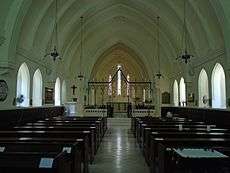Church of the Holy Trinity, Sliema
The Church of the Holy Trinity is an Anglican church in Sliema, Malta.
| Holy Trinity Church | |
|---|---|
| The Parish Church of the Holy Trinity | |
Il-knisja tat-Trinita Qaddisa | |
 Holy Trinity Church | |
| 35°54′35.5″N 14°29′45.6″E | |
| Location | Sliema |
| Country | Malta |
| Denomination | Church of England |
| History | |
| Status | Active |
| Founded | 20 September 1866 |
| Founder(s) | Walter Trower |
| Dedication | Holy Trinity by Acting-Governor, Major-General Ridley, |
| Consecrated | 23 April 1867 |
| Architecture | |
| Functional status | Parish Church |
| Architect(s) | Webster Paulson of G.M. Hills of London |
| Architectural type | Country English Church |
| Style | High Victorian Gothic |
| Construction cost | £4000 |
| Administration | |
| Archdeaconry | Italy and Malta |
| Diocese | Diocese in Europe |
| Province | Canterbury |
| Clergy | |
| Bishop(s) | Robert Innes |
| Chaplain(s) | Clem Upton |
| Laity | |
| Reader(s) | David Felgate |
| Churchwarden(s) | Aileen Grech Ursula Smith |
Origins

The land upon which the church and the adjacent Bishop's house are build was acquired by Jane Trower, the daughter of Walter Trower Bishop of Gibraltar for £1050. She intended to donate the property to the Diocese of Europe but the law did not permit an unmarried woman to make a donation exceeding £50. So her father became party to the Deed of Gift and refunded the money back to her. The church architecture is not common in Malta. The church was built to resemble an English village church.[1]
In 1865, Webster Paulson was commissioned as a contractor in the construction of the church, which was built to designs of Gordon MacDonald Hills (1826-1895).
The church was completed in 1866 and opened to the public. It was consecrated on April 23, 1867 by Bishop Walter Trower of Gibraltar.[2]
The Reverend Dr Thomas Burbidge was the first vicar of the church.
Bishop's House
The building adjacent to the church is known as the Bishop's House. It was built in 1855 as a residence for the vicar. Today the house still serves the same purpose.
Further reading
- Gauci, M. (2009). "New Light On Webster Paulson and his Architectural Idiosyncrasies" (PDF). Proceedings of History Week (PHW). 12 (9): 137–150. ISBN 978-99932-7-400-1. Archived from the original (PDF) on 2017-07-29. Retrieved 2017-07-29.
See also
- Culture of Malta
- History of Malta
- List of Churches in Malta
- Religion in Malta
References
- "HOLY TRINITY CHURCH SLIEMA" Archived 2014-10-24 at the Wayback Machine. Retrieved on 23 October 2014.
- Mallia, Slav (1990). "The Malta Protestant College". Melita Historica. New Series. 10 (3): 257–282. Archived from the original on 26 May 2018.